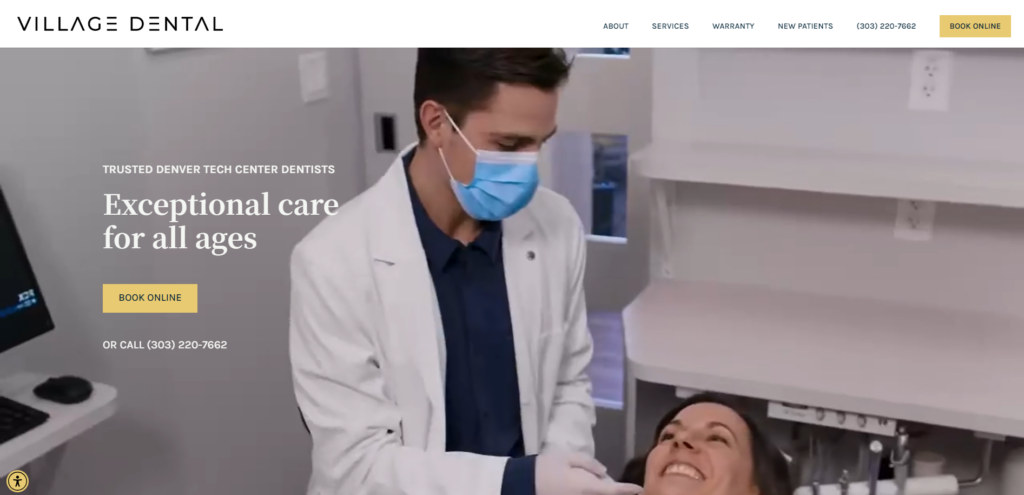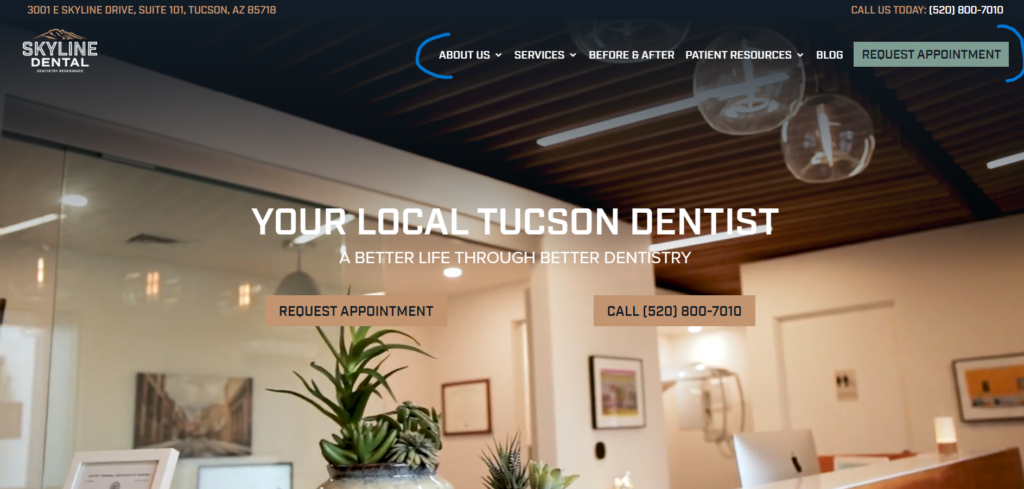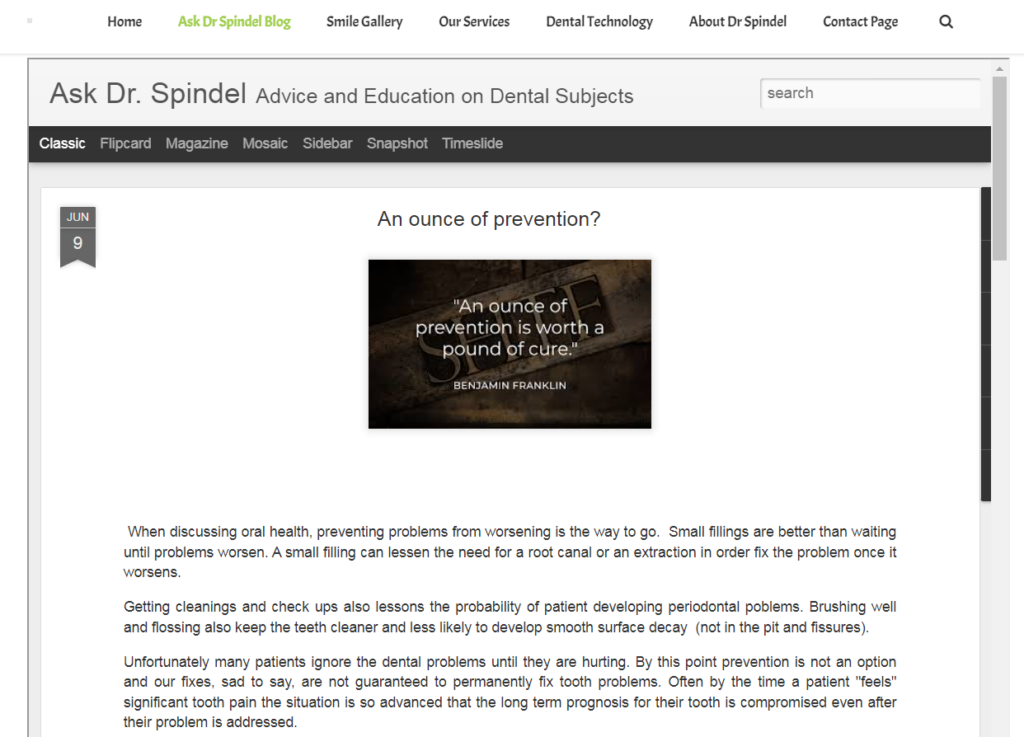Effective web design for dentists is crucial in today’s digital landscape. A well-designed website not only attracts new patients but also enhances their experience and encourages them to book appointments. However, many dentists face challenges such as poor navigation, lack of mobile optimization, and ineffective SEO practices, which can hinder their online success.
This article highlights the five most common web design mistakes dentists should avoid. By addressing these pitfalls, dental practices can improve their online presence, attract more patients, and grow their practice. Let’s dive into the key mistakes to avoid to ensure your dental website stands out and performs optimally.
- Web Design For Dentists – Mistake 1: Ignoring Mobile Optimization
- Web Design For Dentists – Mistake 2: Poor Navigation and User Experience
- Web Design For Dentists – Mistake 3: Lack of SEO Best Practices
- Web Design For Dentists – Mistake 4: Ineffective Call-to-Actions (CTAs)
- Web Design For Dentists – Mistake 5: Neglecting Content Quality
- FAQs
Web Design For Dentists – Mistake 1: Ignoring Mobile Optimization
In web design for dentists, just like any other business, a mobile-friendly website is no longer optional. Over 95% of users access websites via mobile devices, making it imperative for dental practices to optimize their sites for smartphones and tablets. Ignoring mobile optimization can lead to several negative consequences.

Importance of Mobile-Friendly Design
- User Behavior: Many of your potential patients are browsing on mobile devices. If your website isn’t optimized for mobile, you’re missing out on engaging a majority of your audience.
- SEO Impact: Search engines like Google prioritize mobile-friendly sites in their rankings, meaning a lack of optimization can hurt your visibility.

Consequences of Ignoring Mobile Optimization
- High Bounce Rates: Visitors will likely leave quickly if your site isn’t mobile-friendly, resulting in high bounce rates.
- Loss of Potential Patients: A poor mobile experience can frustrate users, causing them to seek dental services elsewhere.
Tips to Ensure Mobile Optimization
- Responsive Design: Implement a responsive design that adjusts seamlessly to different screen sizes, providing a consistent user experience.
- Fast Load Times: Optimize images and minimize code to ensure quick load times, which is crucial for retaining mobile users.
- Simplified Navigation: Design a clean, intuitive navigation system that makes it easy for users to find information quickly on smaller screens.
By prioritizing mobile optimization, dental practices can enhance user experience, improve search engine rankings, and ultimately attract and retain more patients.
Web Design For Dentists – Mistake 2: Poor Navigation and User Experience
A seamless user experience is essential for retaining visitors and converting them into patients. Intuitive navigation is a cornerstone of good web design, helping users find the information they need quickly and efficiently.
Importance of Intuitive Navigation
- User Efficiency: Easy-to-navigate websites enable users to find information swiftly, enhancing their overall experience. A well-structured navigation keeps users engaged and reduces frustration.
- SEO Benefits: Search engines favor websites that offer a good user experience, which includes intuitive navigation. This can improve your search rankings, driving more organic traffic to your site.
Consequences of Poor Navigation
- Frustration: Visitors who can’t find what they’re looking for quickly will likely become frustrated and leave your site.
- Increased Bounce Rates: Poor navigation can lead to higher bounce rates as users abandon your site in favor of more user-friendly options.
- Decreased Patient Inquiries: If potential patients can’t easily find contact information or service details, they are less likely to make inquiries or book appointments.
Tips to Improve Navigation
- Clear Menu Structure: Organize your menu logically, with categories that make sense to users. Include main services and key information prominently.
- Prominent Contact Information: Ensure your contact details are easy to find on every page. This could be in the header, footer, or a dedicated contact page.
- Easy-to-Find Service Pages: Ensure pages detailing your services are easily accessible from the main menu. Use descriptive labels for these pages to ensure users know exactly what they’re clicking on.

By improving navigation and enhancing user experience, dental websites can keep visitors engaged, reduce bounce rates, and increase patient inquiries, leading to better conversion rates and more satisfied patients.
Web Design For Dentists – Mistake 3: Lack of SEO Best Practices
Implementing SEO best practices is crucial for increasing your dental website’s visibility in search engine results and attracting more potential patients.
Importance of SEO for Dental Websites
- Increased Visibility: SEO helps your website rank higher in search results, making it easier for potential patients to find you. Well-optimized websites experience a significant increase in organic traffic.
- Local SEO Impact: Local SEO is particularly important for dental practices to attract nearby patients searching for services.
Consequences of Neglecting SEO
- Lower Search Rankings: Without SEO, your website is less likely to appear on the first page of search results, reducing its visibility.
- Reduced Website Traffic: Lower visibility translates to fewer visitors, negatively impacting patient inquiries and appointments.
SEO Best Practices
- Use of Relevant Keywords: Identify and incorporate keywords that potential patients will likely use when searching for dental services. Tools like Google Keyword Planner can help find these keywords.
- Creation of Individual Service Pages: Each service you offer should have its own dedicated page. This not only improves user experience but also allows for better keyword targeting.
- Optimization of Meta Tags and Headers: Ensure each page has unique and descriptive meta titles and descriptions and properly structured header tags (H1, H2, etc.). This helps search engines understand the content of your pages and improves your ranking.
Adhering to these SEO best practices can help dental websites achieve higher search rankings, attract more traffic, and ultimately convert more visitors into patients. Implementing these strategies ensures your dental practice stands out in a competitive online landscape.
Web Design For Dentists – Mistake 4: Ineffective Call-to-Actions (CTAs)
Effective call-to-actions (CTAs) are vital for driving conversions and engaging potential patients on your dental website.
Importance of Compelling CTAs
- Drives Conversions: CTAs guide visitors towards taking desired actions, such as booking an appointment or signing up for a newsletter. Well-crafted CTAs significantly boost conversion rates.
- Patient Engagement: Compelling CTAs keep visitors engaged and encourage them to interact more with your site, increasing the likelihood of converting them into patients.
Consequences of Ineffective CTAs
- Lower Conversion Rates: Without clear and enticing CTAs, visitors may leave your site without taking any action, resulting in missed opportunities to convert them into patients.
- Missed Opportunities: Ineffective CTAs can cause potential patients to hesitate or abandon the process, leading to a loss of potential revenue and growth for your practice.
Tips for Effective CTAs
- Use Actionable Language: Use strong, action-oriented words that tell visitors exactly what to do, such as “Book Your Appointment Now” or “Get Your Free Consultation.“
- Place CTAs Strategically: Position CTAs where they are easily visible, such as at the top of the page, within the content, and at the bottom. This ensures that visitors encounter them as they navigate through your site.
- Ensure Visibility and Contrast: Design CTAs to stand out by using contrasting colors and prominent buttons. Make sure they catch the visitor’s eye and are easy to find on the page.

By implementing effective CTAs, dental websites can significantly enhance user engagement and conversion rates, ultimately driving more appointments and growth for the practice.
Web Design For Dentists – Mistake 5: Neglecting Content Quality
High-quality content is crucial for a dental website as it educates patients and builds trust in your practice.
Importance of High-Quality Content
- Educates Patients: Informative content helps patients understand their dental issues and the available treatments, empowering them to make informed decisions.
- Builds Trust: Well-written and accurate content establishes your practice as a credible source of information, fostering trust and encouraging potential patients to choose your services.

Consequences of Poor Content
- Reduced Engagement: Low-quality content fails to engage visitors, leading them to leave your site without taking any action.
- Lower Search Rankings: Search engines prioritize high-quality, relevant content. Poor content can result in lower search engine rankings, reducing your website’s visibility and traffic.
Tips for Quality Content
- Regularly Update Blog Posts: Keep your content fresh and relevant by regularly updating your blog with new posts on dental health topics, treatment options, and preventive care tips.
- Include Informative Videos and Patient Testimonials: Videos can explain complex procedures in an easily digestible format, while patient testimonials build trust by showcasing positive experiences with your practice.
- Ensure Clarity and Relevance: Write in clear, concise language that your patients can easily understand. Ensure all content is relevant to your audience’s needs and interests.
By focusing on high-quality content, dental websites can enhance patient engagement, improve search engine rankings, and build a strong, trustworthy online presence. This leads to better patient education, increased trust, and ultimately, more appointments and practice growth.
Transform Your Dental Website with Flying V Group
Creating an effective web design for dentists requires expertise and deep industry insights. Flying V Group specializes in designing high-converting websites that attract and retain patients. With our extensive experience across various challenging fields, we understand the technical nuances and strategies needed for success. From mobile optimization and intuitive navigation to SEO best practices and compelling content, we ensure every aspect of your website is optimized for performance. Don’t leave your online presence to chance. Trust Flying V Group to deliver tangible results and elevate your dental practice to new heights. Contact us today to start transforming your website and driving growth for your business.
FAQs
1. Why is mobile optimization important for dental websites?
Mobile optimization is crucial because over 50% of users access websites via mobile devices. A mobile-friendly site ensures a seamless user experience, leading to lower bounce rates and higher patient engagement.
2. How does SEO benefit a dental website?
SEO increases your website’s visibility in search engine results, attracting more organic traffic. This leads to higher patient inquiries and appointments, ultimately boosting your practice’s growth.
3. What are some essential elements of effective dental web design?
Key elements include responsive design, intuitive navigation, high-quality content, compelling CTAs, and proper SEO implementation. These elements ensure a user-friendly experience and higher conversion rates.
4. How can I improve my dental website’s navigation?
Improve navigation by using a clear menu structure, prominently displaying contact information, and ensuring easy access to service pages. This helps users find information quickly and reduces frustration.
5. Why should I include patient testimonials on my dental website?
Patient testimonials build trust and credibility, showcasing positive experiences and encouraging potential patients to choose your practice. They provide social proof and enhance the overall appeal of your website.






0 Comments